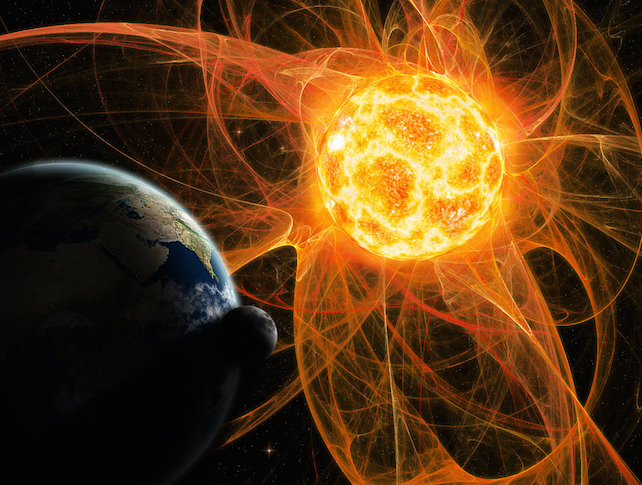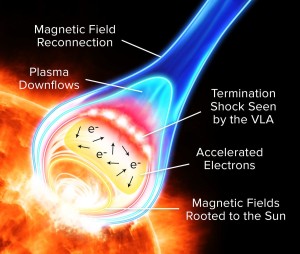How Solar Flares Make Matter Move at (Nearly) the Speed of Light
Solar flares aren’t just fearsome displays of power capable of sending Earth’s technology back 200 years. They are also peculiar stellar phenomena that generate so much energy, they make particles move at nearly the speed of light. To that end, they may be models of future space travel. But how exactly they work that kind of magic stumps the scientific community.
A new study published Thursday in the journal Science might have some answers. Using data gathered by the National Science Foundations’ Karl G. Jansky Very Large Array radio telescope, Bin Chen and others at the Harvard-Smithsonian Center for Astrophysics have put forth a proposal involving something they call “termination shock.”
When solar flares erupt off the surface of the sun, they eject big amounts of material out into space. These eruptions are thought to be caused by the sudden reconfiguration of magnetic fields, but it was still unclear how and why magnetic behavior was responsible for firing charged particles off at such high speeds.
Through the VLA, Chen and his colleagues found that fast plasma flows during a solar fare can impact dense magnetic loops and create a stationery shock — or termination shock — that repeatedly hits particles and accelerates them to faster speeds.
“Our work made a significant progress in understanding this physical process,” says Chen. He says the findings also have “implications for other fields in space physics and astrophysics, because particle acceleration is not only an important aspect of solar flares, but also a fundamental physical process occurring throughout the universe.”
Chen emphasizes that these observations wouldn’t have been possible without recent upgrades to the VLA, allowing astronomers to take up to 40,000 individual radio images in a single second. “This raw power of the VLA is the key to probing the radio emission associated with the flare termination shock,” he says.
Though fascinating, the findings are just the first step for understanding the role of termination shock in solar flares. “We would like to observe more solar flare events like this to see whether or how the situation would change under different physical conditions,” says Chen.
Unfortunately, the VLA isn’t designed for such a high degree of solar research. Chen hopes to follow up on this reproach using the Owens Valley Solar Array operated by the New Jersey Institute of Technology, where he will be next spring.






